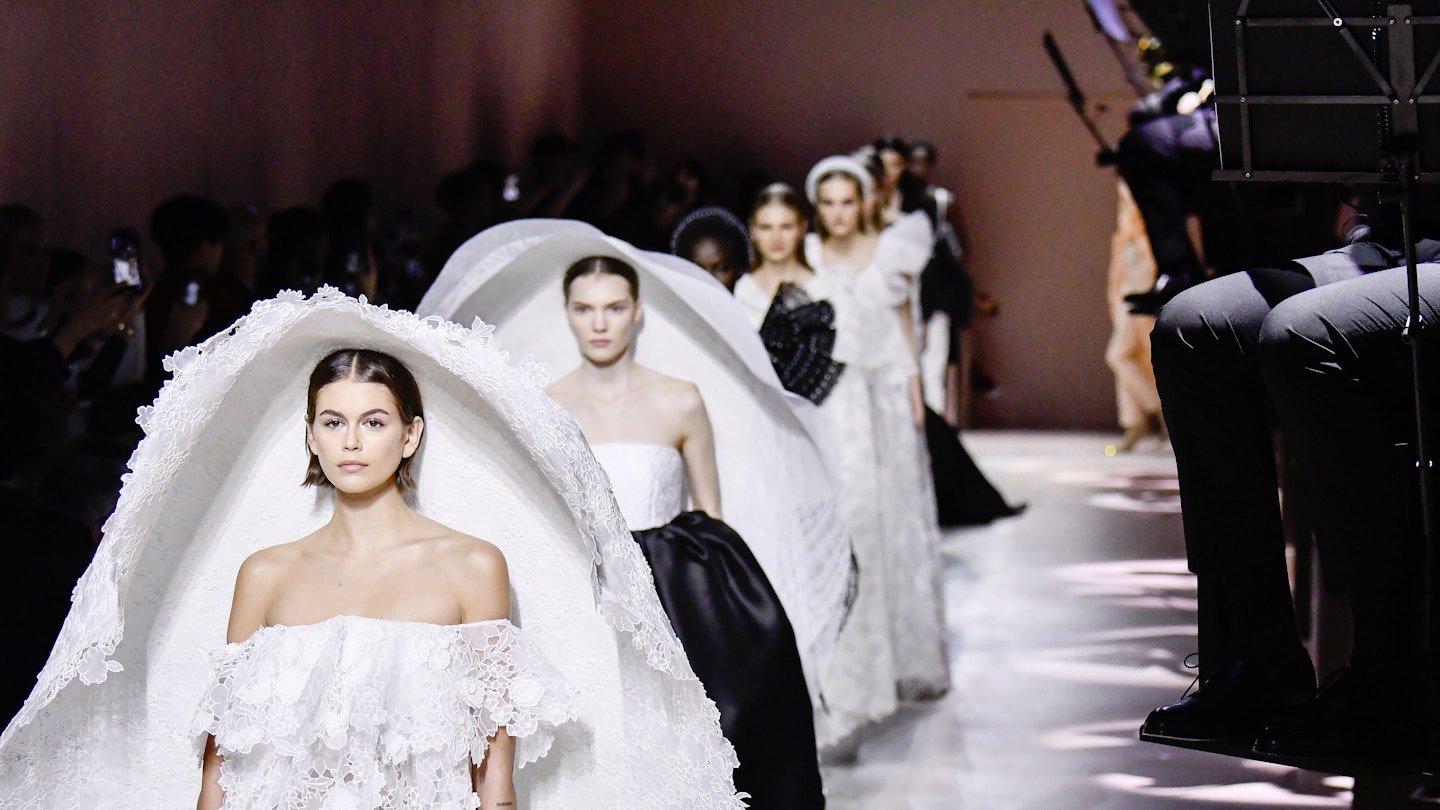The haute couture has historically seemed a bubble of frivolity and privilege. It can be hard to reconcile it — the purpose of it, the relevancy of it — with an age as fraught as this one. But its power to invite the mind to wander and consider the peerless handcraft behind, say, a woven pelerine collar at Chanel, deconstructed trench coat at Margiela, or the drama of an evening glove that explodes into a bouquet of frills at Valentino, has its value now too.
While the ready to wear circuit has lately felt like a platform for ever-pressing political and social commentary about ever-worrying world events, last week’s Paris couture shows in contrast felt like a respite from it. Against a backdrop of a dizzying news cycle of impeachment hearings, climate discussions, Megxit and a new super virus, the couture collections served as a reminder of the power clothes have to make a woman feel inspired, empowered and energised by the simple act of dressing up, even as she navigates the curveballs of her reality.
‘I don’t think we do that enough,’ said Chanel guest actor Ellie Bamber, dressed in merlot coloured tweed. ‘I think there is something really special about that, dressing up in our day to day lives — for dinner, for example.’

And although the week has been dominated by eveningwear, the gap seems to be closing between the ideas we see presented at couture and the looks that turn up in our own closets. Take for instance, that collar at Chanel. It was a recurring thread in Creative Director’s Virginie Viard’s collection, which was her strongest to date since taking the reins of the storied house a year ago. The collar was just one of many elements taken from the classic schoolgirl’s uniform and re-imagined for the Chanel woman.
‘I wanted floral embroideries like an herbarium, delicate flowers. …I also liked the idea of the boarder, of the schoolgirl, the outfits worn by children long ago” - Virginie Viard

Viard was inspired by the cloister gardens of the Abbey of Aubazine, the orphanage where Gabrielle Chanel spent part of her childhood following the death of her mother. “What I immediately liked was that the cloister garden was uncultivated. It was really sunny. The place made me think of the summer, a breeze fragranced with flowers,” Viard explained backstage. ‘I wanted floral embroideries like an herbarium, delicate flowers. …I also liked the idea of the boarder, of the schoolgirl, the outfits worn by children long ago” with “the collars and smocks.” So she created tweed suits and dresses that had an elongated line and youthful cool, their white collars sealing a sweet, if not surprising trend, that had been percolating on social media for weeks. If you follow fashion’s more popular insiders and influencers, no doubt you will have seen the look on the likes of Leandra Medine, Daisy Hoppen and Tamu McPherson, to name a few.
It’s not hard to imagine Viard’s couture — a much more pared back and wearable vision of Chanel than the larger than life statements Karl Lagerfeld made — slotting seamlessly into any one of their wardrobes.

At Dior, Maria Grazia Chiuri also looked to the past to create a more modern, wearable — though no less rarefied — take on couture. Specifically, she looked back to the artist Judy Chicago’s iconic work of the 1970s and invited her to collaborate; their partnership yielding a large building-sized, goddess-shaped, womb-like structure that doubled as show venue. Inside, Chiuri showed fluid, gilded Grecian dresses, metallic suiting and ivory gowns underneath signs that posed the questions: What If Women Ruled The World? Would God Be Female? Would There Be Equal Parenting? ‘I never want to make clothes that are not contemporary for real women today,’ she explained backstage. ‘Because to make a reproduction of archive becomes costume. I don’t want what I do to become costume. I don’t like to create something that is not a real dress, real jacket, real pants. My approach in fashion is like a designer. In other cases you are doing another job; to me that is costumey, that is another thing.

Meanwhile Clare Waight Keller presented a different kind of case for dressing up at Givenchy, with dresses that went big on the volume she’s explored since joining the house with dramatic flounces, frills and flourishes. ‘I wanted to really amplify it to the biggest scale,’ she said backstage. Like the floral swirls and embroideries in Viard’s tulle at Chanel, Keller’s dramatic swoops and poufs were also inspired by a garden — this time those at Sissinghurst — with dramatic shapes that referenced the height of Givenchy’s Audrey Hepburn era, some of the looks topped off with enormous, fantastical hats. Brazenly emotive and dramatic, Keller’s dressing up was the stuff of red carpets or the elaborate wedding of dreams.
Speaking of the former, Giorgio Armani showed plenty of variations on his much-loved soigné silhouette to see his global cult of A-list followers through awards season, starting with actors Reese Witherspoon and Bel Powley, who both sat front row.

At Valentino, Pierpaolo Piccoli ended the week on a creative high with a line-up of dresses that reigned in the outsized, romantic shapes that had earned him such widespread adoration and praise among critics and Internet fans alike. (He’s the man who set off the wave of big poufs and frills trickling down to the contemporary market and high street.) Not that the work was short on impact, poetry or desirability. The opposite, in fact. The sight of women of all ages and backgrounds — Stella Tennant, Adut Akech, Karen Elson, Natasha Poly, Kaia Gerber, the list goes on — owning the runway in his richly colourful and regal take on glamour, without any loaded subtext, was perhaps the most compelling case for couture’s relevancy of all.
